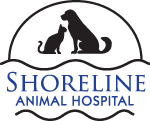Dental Care
Did you know that over 80% of dogs and 70% of cats develop dental disease by the time they reach three years old? Dental problems can cause severe discomfort for pets, and if left untreated, they become more complex and expensive to treat. What’s more, improper dental care can lead to serious illnesses. Neglected oral health can result in harmful oral bacteria entering the bloodstream and damaging vital organs like the heart, liver, and kidneys.
If you notice any of these signs in your pet, it’s crucial to book an appointment immediately:
Symptoms of Periodontal Disease
Take action immediately if you notice any of these signs in your pet:
- Tartar buildup (yellow or brown) on their teeth
- Swollen, red, or bleeding gums
- Persistent bad breath
- Excessive drooling
- Changes in eating or chewing habits
- Pawing at the face
- Loose teeth
- Uncharacteristic depression

Comprehensive Oral Exams
Ensuring your pet receives proper dental care is one of the simplest ways to protect their well-being and keep them free from pain. Our highly skilled team conducts thorough oral exams where we meticulously examine your pet’s mouth, teeth, and jaw. As part of this process, we may recommend dental X-rays to assess the health of their tooth roots. Regular oral exams are integral in preventing irreversible dental disease, tooth loss, and possibly costly oral surgeries.
Professional Teeth Cleanings
At our veterinary clinic, we begin your pet’s teeth cleaning with a comprehensive physical examination to evaluate their overall health. After the initial examination, a safe and painless anesthetic is administered, enabling us to perform a thorough cleaning. Since most dental diseases stem from below the gumline, we start by removing tartar using a hand scaler. We then utilize an ultrasonic scaler to effectively clean above the gums, while a curette is used to meticulously clean and smoothen the teeth under the gum line. To complete the process, we polish the teeth and wash the gums with an anti-bacterial solution, helping to delay the recurrence of tartar buildup.
Extractions and Advanced Procedures
Our veterinary experts prioritize your pet’s wellbeing, recommending tooth extractions only when necessary. If we identify an infected or broken tooth causing your pet pain, we may suggest extraction as the optimum solution. We will provide you with detailed information on the procedure and guide you on how to care for your pet during the healing process.
Taking a Proactive Approach to Prevent Dental Disease
Being proactive is crucial in preventing dental disease before it becomes a more significant concern. Regular wellness visits provide us with the opportunity for meticulous examination of your pet’s mouth and teeth, enabling early detection and intervention. Early-stage dental disease can frequently be reversed through thorough cleaning. This highlights the importance of adopting a proactive stance towards dental health, focusing on prevention rather than reacting to problems that may arise. Additionally, incorporating at-home dental care practices such as regular brushing and incorporating teeth cleaning treats into your pet’s routine can effectively minimize plaque buildup. In addition, we advise against providing your pet with hard toys and bones that could potentially cause dental damage.
Prioritize your pet’s dental health to ensure a happy and healthy future. Schedule an appointment with our experienced team at Shoreline Animal Hospital for comprehensive dental care tailored specifically to your beloved companion’s needs.

